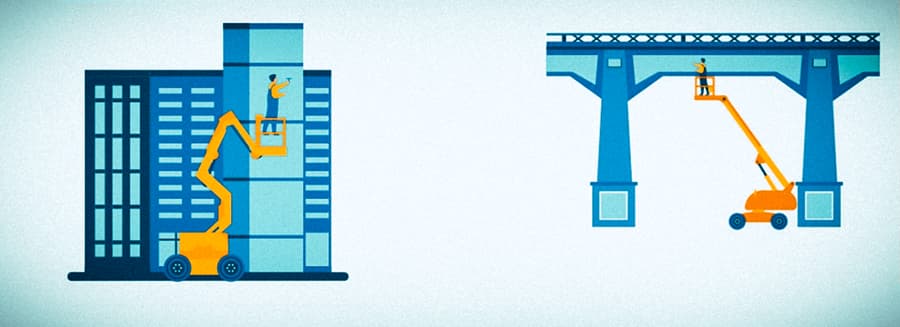Table of Contents
Of the various types of boom lifts available, two of the most commonly used are articulating boom lifts and telescopic boom lifts. Understanding the difference between articulating and telescopic boom lifts is essential for anyone working in construction, maintenance, or any industry that requires working at height. The right choice of boom lifts can significantly impact productivity, safety, and the success of your entire project.
This blog post aims to shed light on the key differences between articulated and telescopic boom lifts. We’ll explore their unique features, benefits, and ideal use cases.
What is an articulating boom lift?
Articulating boom lifts, also called articulated boom lift, is a versatile aerial platform that features multiple hinged sections or “joints.” These sections allow the boom to bend and telescope, providing a high degree of maneuverability and positioning accuracy.

Key features of articulating boom lifts:
Multiple joints: The boom typically has two or more articulating points, allowing it to bend in multiple directions.
Up-and-over capability: This design enables the lift to reach over obstacles and around corners.
Compact base: Many articulating boom lifts have a relatively small footprint, making them suitable for confined spaces.
Variable reach: The articulating design allows for both vertical and horizontal reach adjustments.
What is a telescopic boom lift?
Telescopic boom lifts, also called straight boom lifts or straight arm lifts, have a retractable straight arm that can reach great heights and distances. This type of lift is designed for maximum horizontal reach and vertical height.

Key features of telescopic boom lifts:
Single, extendable arm: The boom consists of nested sections that extend outward, similar to a telescope.
Greater reach: Telescopic booms generally offer more horizontal reach than articulating booms.
Higher working heights: These lifts can typically reach higher elevations than their articulating counterparts.
Stability at height: The straight design provides excellent stability when fully extended.
360-degree rotation: Like articulating booms, telescopic booms can usually rotate fully.
Larger platform capacity: Many telescopic boom lifts can accommodate heavier loads and more workers.
How to Choose the Right Boom Lift

Vertical and Horizontal Reach
- Articulating boom lifts typically have a range of 30 to 150 feet. Most models of articulating boom lifts have a 360-degree base turntable so they can rotate in any direction, reaching locations that telescopic boom lifts can’t.
- Telescopic boom lifts have a range of 40 to 210 feet or more. Although telescopic boom lifts can’t bend and adjust like articulating boom lifts, telescopic boom lifts can reach higher heights than articulating boom lifts.
Telescopic boom lifts typically have greater vertical and horizontal reach than articulating boom lifts, making them more suitable for outdoor high-rise construction. Articulating boom lifts are better at getting around certain obstacles or places, making them ideal for indoor operations such as warehouses.

Maneuverability
- Telescopic boom lifts typically have a greater vertical and horizontal reach than articulated boom lifts, requiring a larger workspace and ample room to achieve their reach. Very outdoor work, such as working at height on construction sites such as building buildings, bridges, etc.
- Articulating boom lifts are better at getting around certain obstacles or places, and are ideal for working in narrow spaces, such as organizing warehouse shelves, repairing roofs, ceilings, etc.
Platform Capacity
- Articulating boom lifts are generally lower in lifting capacity, usually between 500 and 1,000 pounds.
- Telescopic boom lifts are generally higher in lifting capacity, ranging from 500 to 2,000 pounds or more. This is also consistent with the fact that articulating boom lifts are more suitable for indoor use and telescopic boom lifts are more suitable for outdoor use.
Cost
Due to the more complex design of articulating boom lifts compared to telescopic boom lifts, they are generally more expensive. Although the initial cost of a straight boom lift may be higher. Therefore, choosing a trusted used boom lifts supplier and purchasing high-quality used boom lift is a very economical choice
In short, when you need maximum reach, consider telescopic boom lifts. When you need to get around obstacles, consider articulating boom lifts.
When choosing between articulated and telescopic boom lifts, consider the specific requirements of your project, such as the capacity, outreach, the environment, and of course, your budget.
If you’re still unsure, Contact Holdwell, which offers new & used lifts. We can provide personalized advice based on your unique needs.




